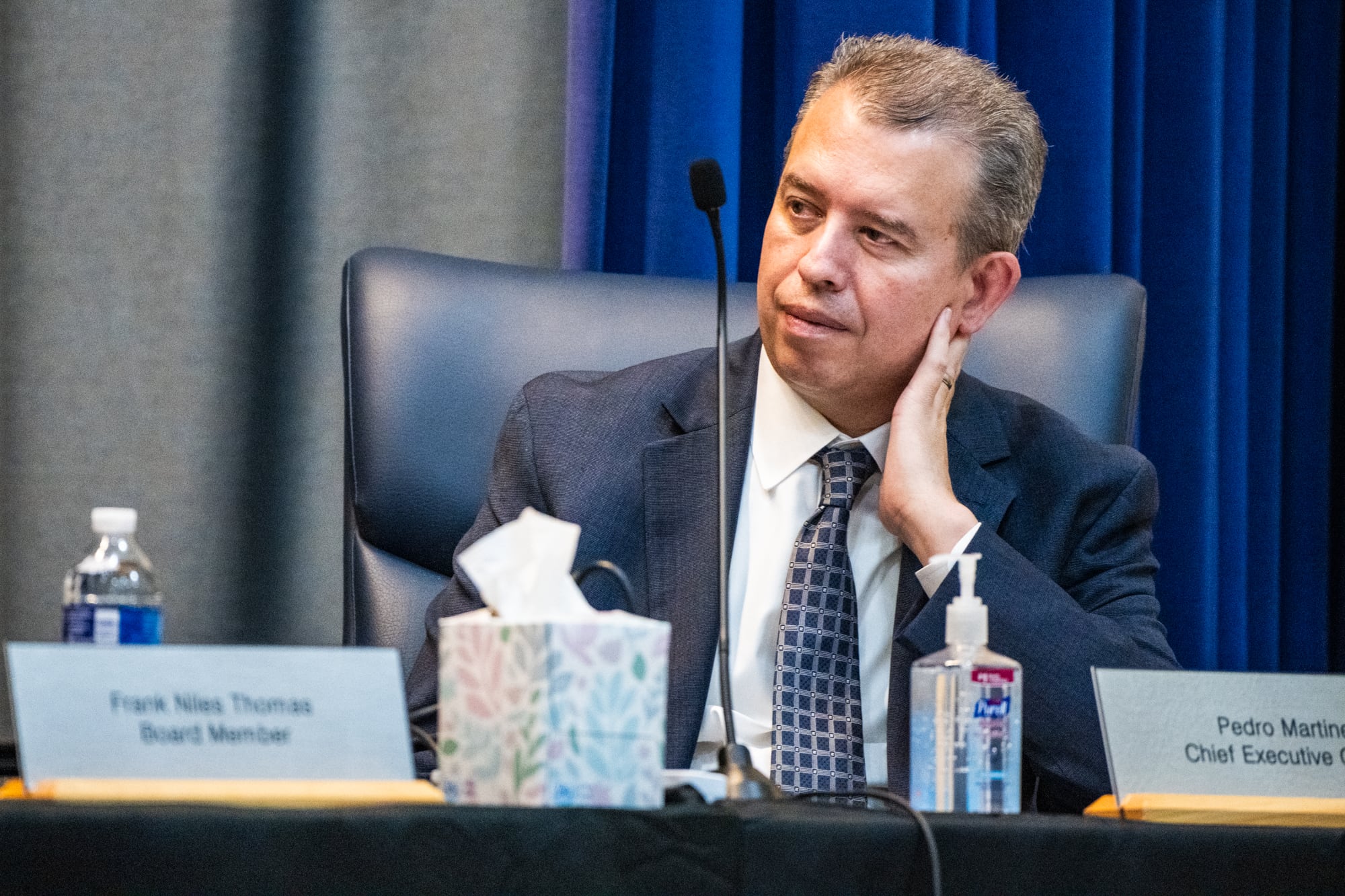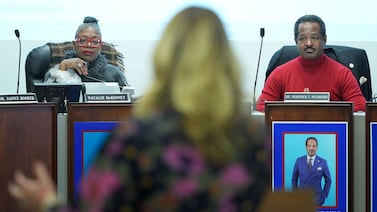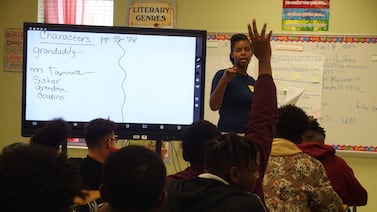Sign up for Chalkbeat Chicago’s free daily newsletter to keep up with the latest news on Chicago Public Schools.
Chicago Public Schools CEO Pedro Martinez is leaving this week after three and a half turbulent years at its helm.
He took over at the height of the COVID pandemic, just as schools were navigating a rocky return to full-time in-person instruction and taking stock of the damage to student learning and mental health. School leaders have credited him with steering the district to a post-COVID normal, and the district has gotten some national recognition for its efforts to bounce back from the pandemic’s academic toll, especially in reading.
But the past year brought fresh upheaval: Mayor Brandon Johnson, a former Chicago Teachers Union employee, and the union clashed bitterly with Martinez after he balked at the union’s far-reaching contract demands. For the past year, Martinez has argued the mayor should release all the money from special taxing districts known as TIFs and end their existence in order to solve the school system’s financial woes. Johnson has released surplus funds from those districts and several are set to be dissolved in the coming years.
With backing from the largely Johnson-appointed school board, Martinez refused to borrow to cover the contract and a controversial staff pension payment. Then came the resignation of the full board, much acrimonious back-and-forth as the mayor and union sought to oust him, and eventually — at a hastily called meeting days before Christmas — Martinez’s dismissal by the new school board without cause. Under his contract, he stayed on for another six months.
More recently, the CEO settled a new four-year contract with teachers, but he is heading out only after filing defamation claims against the union president, Stacy Davis Gates, and the school board president.
Martinez is an alum of CPS’s Benito Juarez High School and served as the district’s chief financial officer from 2003 to 2009. He served as a deputy superintendent and superintendent in two districts in Nevada, including Clark County, which includes Las Vegas. Martinez was superintendent of the San Antonio Independent School District for six years before being hired by former Mayor Lori Lightfoot’s administration in 2021. He starts as the education commissioner of Massachusetts later this summer.
Chalkbeat Chicago recently spoke with Martinez about his firing, the unfinished business of his tenure as CEO, and his advice for his successor in the face of a massive budget deficit, lingering academic fallout from the pandemic, and threats from the Trump administration to withhold funding.
This interview has been lightly edited for clarity and brevity.
You are leaving Chicago because a school board appointed by Mayor Johnson fired you in late December. Do you wish you had navigated your relationship with the mayor and with his allies at the Chicago Teachers Union differently so you could have kept your job?
It was about standing up for what I believe in — standing up for what’s right. I could not agree to irresponsible borrowing when there are other solutions. When I was here the first time, I had served as a chief financial officer for most of that time. At that time, the district had strong credit ratings. We were able to borrow at low interest rates. We had over a billion dollars in the bank. We never borrowed for payroll.
I left for 12 years and came back to find the district with the lowest credit rating you can have. We’re the second largest junk bond producer in the country, and the only one that’s higher is Puerto Rico.
During the 2015 to 2018 era, the district was having significant deficits. Because of that, we have $2 billion [in debt] by now on our balance sheets, and it’s made up of almost all interest. That’s part of our structural deficit today. I could not agree to do more of the same when we have solutions already on the table. Who brought this to my attention, ironically, was the teachers union because they’ve been such strong advocates of expiring TIFs and releasing TIFs. And they’ve been right all along. I didn’t realize how big these TIFs had gotten. I was shocked when I saw the numbers.
This was about taking a stand, trying to make sure that we were putting the district on a responsible path, especially when we’re seeing so much evidence of success. We’re seeing for the first time in the district’s history our Black students are leading our literacy gains. Our Latinx students are also showing significant gains. We have no race gaps when it comes to early college and dual credit programs. My Latinx students outperform the nation when it comes to Advanced Placement exams. Early on when I was talking to the mayor, he was really impressed by the results we were getting.
Didn’t some of the earlier borrowing that led to the district’s ballooning debt burden happen during your first tenure in the district?
During my tenure as CFO, the only bonds we ever did were for capital improvements. When I look back in terms of the positions that I took, I have no regrets.
So you are not second-guessing the way you handled the conflict with the mayor and union last year, even though it resulted in you losing your job?
What I do regret is that I thought it would be a lot easier to convince the mayor based on the fact that his union was the strongest advocate for TIFs when we showed him the numbers. I thought it was going to be easy. The school board that resigned was fully on board. That’s why they passed the budget the way they did. That’s the one regret I have: I didn’t realize that there would be a misalignment.
The Chicago Teachers Union has a harsh assessment of your time at the helm as you’re leaving the district. What is getting in the way of having more cordial relationships with labor?
In Nevada, I had a wonderful relationship with the unions. They were actually my allies, both in southern and northern Nevada. Ruben Murillo, the head of the southern Nevada union, wrote a recommendation letter for me as I was coming to Chicago.
In San Antonio, we started with a very cordial, very collaborative relationship. The state forced us to clash because it was either closing a school or implementing a charter.
In Chicago, we started cordially. Things went separate when Stacy put out her 700 proposals, wanting 14,000 additional staff, wanting to increase our deficit by over $5 billion. The feeling was, “We’re in control. We have the power. We’re going to get what we want.”
My team said there’s no evidence of any of the proposals really leading to more student achievement. In fact, it was the opposite. It was reducing instructional time, which our students need more of, not less. It was teachers having the freedom to teach whatever they want in classrooms when, for the first time, we’re seeing students being exposed to more rigor. It was our weakening teacher evaluation system, which is already not very strong.
I took a stand. No regrets on that, and I would do it again, because it’s important for us as leaders to not just take an easy path. We have to stand up for what’s right, because we’re entrusted with the trust of our families and communities about their children.
The fundamental challenge that led to this clash with the mayor’s office and the union is still very much there: The district is looking at a sizable deficit at a time when a major influx of state funding seems unlikely, a loss of federal funding seems like a possibility, and frankly, the city is dealing with its own financial limitations. What can your successor do about this?
This is a time when the mayor, the board, and the incoming CEO have to come together. The solution is right in front of them again. We have over $3 billion in TIF surplus, and that number is low because we don’t have more recent data in the banks today. There’s a revenue source of over $1.2 billion, which our taxpayers think is already going to the taxing bodies. They think that CPS is getting its portion, with the city, the parks, the City Colleges.
I can’t even take credit for finding the solution. The teachers union has been the strongest advocate for this. It not only helps us, it helps out the city. The mayor wouldn’t have to propose a tax increase if he had released the TIFs. These are revenues that our taxing bodies are being starved of for years.
Would it be fair to acknowledge that there are political and fiscal complexities when it comes to releasing the entirety of those funds to CPS and other city agencies?
When you have over $3 billion in the bank, you have an opportunity to create a long-term plan. The teachers union has always rallied for the immediate expiration of all TIFs and the immediate release of all funds. If that had occurred, I wouldn’t be borrowing for payroll.
What is some work that you regret leaving unfinished or that you didn’t get a chance to tackle during your time?
We got all these gains in spite of not really having support, especially from the unions and from City Hall. And I really credit our principals, our assistant principals, and our teachers and paraprofessionals, who said they would do what’s right for children at a time when the district was very unstable, right at the peak of the pandemic.
This work has never been a one-year or two-year plan. It’s always been a 10-plus-year plan. I feel sad that I can’t see it all the way through, especially because the momentum is so strong, and it is something that just has been exciting.
Earlier on, after you took over, you said that you would be really interested in exploring innovative academic models, especially at the high school level, like the career academies that you launched in San Antonio. Why didn’t the district do that?
We’ve actually created the infrastructure while I’m here. We strengthened our early college programs. We went up four-fold in terms of college credits earned by students through early college and dual credit, and record numbers of students getting associate degrees, getting at least a semester of college credit. I’m also excited about seeing more students than ever getting certifications in career tech. We have more children than ever partnering with the trades, getting apprenticeships with the plumbers and with the electrical unions. I won’t be able to see it all the way through, but that work started under my leadership and will continue.
One post-COVID issue that has been really challenging for Chicago and for many other districts is high chronic absenteeism, especially at the high school level. In my recent reporting on this issue, I did not get a sense that the district really has a comprehensive plan to address that challenge. Why not?
When you look at our chronic absenteeism, it’s at the high school level, and it is with our youngest children, in preschool and kindergarten. I’m less worried about our high school students and more worried about our younger students. With them, the challenge we have is, how do we continue to work with parents so that they understand the value of that early education? Because especially with our children who are starting behind just because of poverty, our best strategy is to get them in as soon as possible. So if I had the ability, I would have the children in full-day preschool at age 3, especially children with disabilities, multilingual students, children who live in poverty. During my term, we finished the expansion of universal preschool across the entire city of Chicago.
At the high school level, attaching attendance to graduation and to academics is a very outdated idea. If anything, what our older students have shown is that they actually did okay and better than their younger peers during the pandemic. They actually are hungry to leverage technology. You’re seeing the world of higher ed going more and more in that way, with more hybrid programs and more online programs. It’s an outdated notion to think that seat time should be a driver for graduation. I am so proud of our high schools that they don’t allow students to just fall through the cracks. The old CPS did that for decades. Now, we make calls at home when children are absent. We do the best we can working with parents.
The Trump administration has come after CPS for its diversity, equity. and inclusion efforts. Do you worry about a loss of federal funding, and how do you think the next CEO should navigate these changes at the federal level?
We have been very strategic and always acted with integrity. So I am not worried about CPS losing funding because of issues around DEI. I worry about other cuts that could happen at the federal level because the federal government right now is under a lot of pressure to cut expenses, and I see a lot of programs being cut that are very essential to our communities. It’s not going to happen immediately. It’s going to be about a year out, at least for education. My call is for everybody to work together to understand these complexities and to continue to advocate for our communities.
What do you see as the top challenge facing the next CPS CEO, and what’s your best advice to the leader who will take over for you?
We don’t need more taxes. We don’t need irresponsible borrowing or financing schemes. We’ve never allowed our structural deficit to get bigger than half a billion dollars, including with all the outrageous demands of the union. I’m asking the mayor, our board, and the incoming CEO to work together. The solution is right in front of them. Longer term, always remember that our district’s talent level is deep, not only at the central level, but also at the school level. The more and more we continue to invest in our schools and to advocate for our schools, we’re going to continue to see strong results.
Correction: A previous version of this article incorrectly stated the year Martinez started as CPS CEO. It was 2021, not 2022.
Mila Koumpilova is Chalkbeat Chicago’s senior reporter covering Chicago Public Schools. Contact Mila at mkoumpilova@chalkbeat.org.





